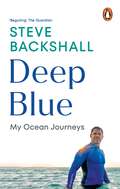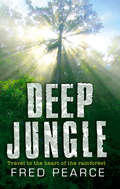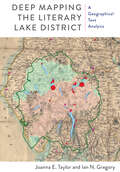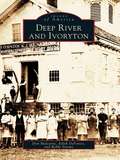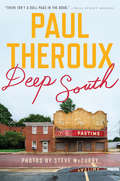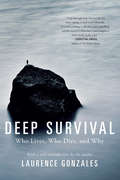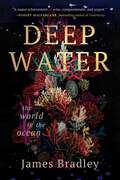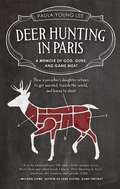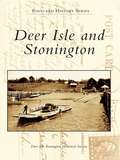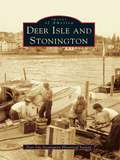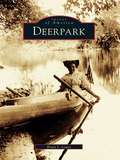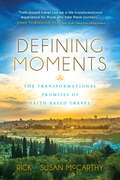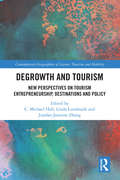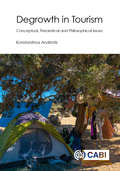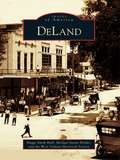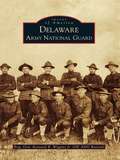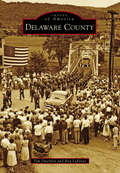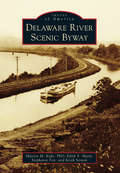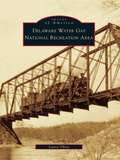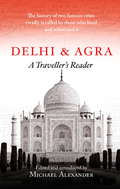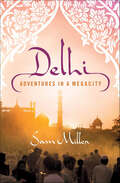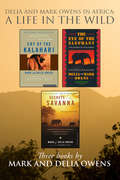- Table View
- List View
Deep Blue: My Ocean Journeys
by Steve BackshallTake a deep breathSteve Backshall was nine years old the first time he saw a shark, while on holiday with his family in Malaysia. It was the beginning of a life-long fascination with these 'lords of the sea', and the oceanic life around them. His career as one of the world's most popular naturalists and explorers has taken him to countless underwater places, many never before seen by others. And he's also been witness to the startling decline in fortune of our oceans' wild inhabitants over the past fifty years.Deep Blue is a book a lifetime in the making: a remarkable blend of memoir, travel, and marine and environmental science that takes us on an unforgettable tour of the many worlds of aquatic life: from underwater deserts and rainforests to the evolution of ocean heroes like the sea turtle and the Great White, from the genesis of ocean life to the rapidly declining state of white polar seas and coral reefs. It's both a love letter to our precious oceans and rallying cry for what we must to do save them.
Deep Jungle: Journey To The Heart Of The Rainforest
by Fred PearceDEEP JUNGLE is an exploration of the most alien and feared habitat on Earth. Starting with man's earliest recorded adventures, Fred Pearce journeys high into the canopy - home to two-thirds of all the creatures on our planet, many of whom never come down to earth. During his travels he encounters all manner of fantastic flora and fauna, including a frog that can glide from tree to tree, a spider that can drag live chickens into its burrow and a flower that smells of decaying flesh.It is in the jungle that Pearce discovers secrets about how evolution works, the intricate links that connect us all, and maybe even clues to where humans came from - here is the key to our future foods and medicines, our climate and our understanding of how life works. At the start of a new millennium Pearce asks why we continue to waste precious time - and billions of dollars - looking for signs of life elsewhere in our universe when the greatest range of life-forms that have ever existed lies right here on our doorstep. Today environmentalists say we are on the verge of destroying the last rainforests, and with them the planet's evolutionary crucible, and maybe even its ability to maintain life on Earth. But nature has a way of getting its own back. The Mayans and the people of Angkor went too far in manipulating nature and paid the ultimate price. Their civilisations died and the jungle returned. Nature reclaimed it's own and it may do so again ...
Deep Mapping the Literary Lake District: A Geographical Text Analysis (Aperçus: Histories Texts Cultures)
by Ian N. Gregory Joanna E. TaylorEngland’s famed Lake District—best known as the place of inspiration for the Wordsworths, Samuel Taylor Coleridge, and other Romantic-era writers—is the locus of this pioneering study, which implements and critiques a new approach to literary analysis in the digital age. Deploying innovative methods from literary studies, corpus linguistics, historical geography, and geographical information science, Deep Mapping the Literary Lake District combines close readings of a body of writing about the region from 1622-1900 with distant approaches to textual analysis. This path-breaking volume exemplifies interdisciplinarity, demonstrating how digital humanities methodologies and geospatial tools can enhance our appreciation of a region whose topography has been long recognized as fundamental to the shape of the poetry and prose produced within it.
Deep River and Ivoryton (Images of America)
by Robbi Storms Don Malcarne Edith DeforestDeep River and Ivoryton, two villages in the lower Connecticut River Valley, were dominated for more than a century by "white gold"-ivory. The growth of the piano industry led to a new use for this exotic and long-treasured substance and, suddenly, the two villages became tied to Zanzibar, the most important exporting place for the tusks of African elephants.With more than two hundred exceptional photographs and narrative, Deep River and Ivoryton tells the story of how ivory shaped the economy and culture of these villages. Two companies, Pratt, Read & Company and the Comstock, Cheney & Company, employed thousands of people in satisfying the demand for new pianos. Probably more than ninety percent of the ivory processed in this country was handled in Deep River and Ivoryton. The demand for new instruments slowed with the invention of the radio, followed by the Great Depression of the 1930s, and the flow of material stopped altogether in the 1950s, when the use of ivory in the United States was banned.
Deep South's Oldest Rivalry, The: Auburn vs. Georgia (Sports)
by Douglas StutsmanThe rivalry between Auburn University and the University of Georgia began in 1892 and has largely been a competition more brotherly than bitter. According to one legend, Auburn’s “War Eagle” battle cry originated at the first game between the two schools. The first overtime game in SEC history occurred in 1996, when Georgia topped the heavily favored Tigers, 56–49, in four extra periods. Renowned UGA coach Vince Dooley graduated from Auburn, while Auburn coach Pat Dye was an All-American at UGA. Join award-winning journalist Doug Stutsman as he recounts the unforgettable games, moments and personalities on the 125th anniversary of the Deep South’s Oldest Rivalry.
Deep South: Four Seasons On Back Roads
by Paul TherouxThe acclaimed author of The Great Railway Bazaar takes a revealing journey through the Southern US in a &“vivid contemporary portrait of rural life&” (Atlanta Journal-Constitution). Paul Theroux has spent decades roaming the globe and writing of his experiences with remote people and far-flung places. Now, for the first time, he turns his attention to a corner of America—the Deep South. On a winding road trip through Mississippi, South Carolina, and elsewhere below the Mason-Dixon, Theroux discovers architectural and artistic wonders, incomparable music, mouth-watering cuisine—and also some of the worst schools, medical care, housing, and unemployment rates in the nation. Most fascinating of all are Theroux&’s many encounters with the people who make the South what it is—from preachers and mayors to quarry workers and gun show enthusiasts. With his astute ear and penetrating mind, Theroux once again demonstrates his &“remarkable gift for getting strangers to reveal themselves&” in this eye-opening excursion into his own country (The New York Times Book Review). &“Paul Theroux&’s latest travel memoir had me at hello…Theroux pulls no punches in his quest to understand this overlooked margin of American life.&” — Boston Globe
Deep Survival: Who Lives, Who Dies, And Why
by Laurence Gonzales"Unique among survival books... stunning... enthralling. Deep Survival makes compelling, and chilling, reading."--Penelope Purdy, Denver Post In ?Deep Survival?, Laurence Gonzalez combines hard science and powerful storytelling to illustrate the mysteries of survival, whether in the wilderness or in meeting any of life's great challenges. This gripping narrative, the first book to describe the art and science of survival, will change the way you see the world. Everyone has a mountain to climb. Everyone has a wilderness inside.
Deep Water: The World in the Ocean
by James Bradley"Deep Water is a major achievement....Bradley's skills both as novelist and essayist converge here to create this wise, compassionate and urgent book, characterized throughout by a clarity of prose and a bracing moral gaze that searches water, self and reader." —ROBERT MACFARLANE, bestselling author of UnderlandIn this thrilling work—a blend of history, science, nature writing, and environmentalism—acclaimed writer James Bradley plunges into the unknown to explore the deepest recesses of the natural world.Seventy-one percent of the earth’s surface is ocean. These waters created, shaped, and continue to sustain not just human life, but all life on Planet Earth, and perhaps beyond it. They serve as the stage for our cultural history—driving human development from evolution through exploration, colonialism, and the modern era of global leisure and trade. They are also the harbingers of the future—much of life on Earth cannot survive if sea levels are too low or too high, temperatures too cold or too warm. Our oceans are vast spaces of immense wonder and beauty, and our relationship to them is innate and awe inspired.Deep Water is both a lyrically written personal meditation and an intriguing wide-ranging reported epic that reckons with our complex connection to the seas. It is a story shaped by tidal movements and deep currents, lit by the insights of philosophers, scientists, artists and other great minds. Bradley takes readers from the atomic creation of the oceans, to the wonders within, such as fish migrations guided by electromagnetic sensing. He describes the impacts of human population shifts by boat and speaks directly and uncompromisingly to the environmental catastrophe that is already impacting our lives. It is also a celebration of the ocean’s glories and the extraordinary efforts of the scientists and researchers who are unlocking its secrets. These myriad strands are woven together into a tapestry of life that captures not only our relationship with the planet, but our past, and perhaps most importantly, what lies ahead for us.A brilliant blend of Robert MacFarlane’s Underland, Susan Casey’s The Underworld, and Simon Winchester’s Pacific and The Atlantic, Deep Water taps into the essence of our planet and who we are.
Deer Hunting in Paris
by Paula Young LeeWhat happens when a Korean-American preacher's kid refuses to get married, travels the world, and quits being vegetarian? She meets her polar opposite on an online dating site while sitting at a café in Paris, France and ends up in Paris, Maine, learning how to hunt. A memoir and a cookbook with recipes that skewer human foibles and celebrates DIY food culture, Deer Hunting in Paris is an unexpectedly funny exploration of a vanishing way of life in a complex cosmopolitan world. Sneezing madly from hay fever, Lee recovers her roots in rural Maine by running after a headless chicken, learning how to sight in a rifle, shooting skeet, and butchering animals. Along the way, she figures out how to keep her boyfriend's conservative Republican family from "mistaking" her for a deer and shooting her at the clothesline.
Deer Isle and Stonington
by Deer Isle-Stonington Historical SocietyThe island communities of Deer Isle and Stonington lie in Penobscot Bay, a region known and loved by sailors the world over. Deer Isle and Stonington portrays life on the island from the age of ferries and steamships, to the building of the Deer Isle-Sedgwick Bridge, through World War II. These vintage photographs allow the reader to watch as the island's main streets grow and change. Represented are landmarks such as the Mark and Pumpkin Island lighthouses, the Stonington Opera House, and the oldest buildings on the island. The vital industries of seafaring, sail making, commercial fishing, granite quarrying, and yachting are pictured here alongside images of everyday life-celebrations and ceremonies, shopping and picnics, education and worship, work and play.
Deer Isle and Stonington (Images of America)
by Deer Isle-Stonington Historical SocietyThe island communities of Deer Isle and Stonington lie in Penobscot Bay, a region known and loved by sailors the world over. Deer Isle and Stonington portrays life on the island from the age of ferries and steamships, to the building of the Deer Isle-Sedgwick Bridge, through World War II. These vintage photographs allow the reader to watch as the island's main streets grow and change. Represented are landmarks such as the Mark and Pumpkin Island lighthouses, the Stonington Opera House, and the oldest buildings on the island. The vital industries of seafaring, sail making, commercial fishing, granite quarrying, and yachting are pictured here alongside images of everyday life-celebrations and ceremonies, shopping and picnics, education and worship, work and play.
Deerpark (Images of America)
by Brian J. LewisBounded by three rivers and a mountain range, the town of Deerpark lies in the southwestern corner of Orange County. Once the frontier of America, the area took its name from what early settlers called their neighbor's fenced tract: McDaniel's Deer Park. The town has seven hamlets-Cahoonzie, Cuddebackville, Godeffroy, Huguenot, Rio, Sparrowbush, and Westbrookville-shaped and identified by their geography.Deerpark highlights a community that has what is believed to be the oldest one-hundred-mile road in the country, the Old Mine Road. Appearing in this pictorial history are the Delaware and Hudson Canal, which transformed the town, and the railroad, which spawned a thriving resort industry. Also shown are filmmaker D.W. Griffith, who between 1909 and 1911 made silent movies using the mountains and rivers as a backdrop, and many ancestors of present-day residents.
Defining Moments: The Transformational Promises of Faith-Based Travel
by Susan McCarthy Rick McCarthyA guide to faith-based, Spirit-led, heart-changing travel to the Holy Land and historic Christian sites throughout Europe.Travel is the one thing that makes you richer after you pay for it—and that’s especially true when itineraries are designed to provide a life-changing spiritual revelation experience. This guide is ideal for individuals and tour leaders who want to bring the Holy Spirit along on their journeys as they seek defining moments with God.Covering destinations such as Antioch, Bethlehem, Emmaus, Corinth, Canterbury, Zurich, and many more, Defining Moments not only allows you to follow in the footsteps of Paul’s missionary journeys or learn more about the Reformation, but deepens your experience in ways that can restore, revive, and re-energize your faith—turning travel into transformation. Also included are numerous practical tips about preparing for your trip, navigating unfamiliar places, touring with a group, and more.
Degrowth and Tourism: New Perspectives on Tourism Entrepreneurship, Destinations and Policy (Contemporary Geographies of Leisure, Tourism and Mobility)
by C. Michael Hall; Linda Lundmark; Jundan Jasmine ZhangThe sustainability of tourism is increasingly under question given the challenges of overtourism, COVID-19 and the contribution of tourism to climate and environmental change. Degrowth and Tourism provides an original response to the central problem of growth in tourism, an imperative that has been intrinsic within tourism practice, and directs the reader to rethink the impacts of tourism and possible alternatives beyond the sustainable growth discourse. Using a multi-scaled approach to investigate degrowth’s macro effects and micro indications in tourism, this book frames degrowth in tourism in terms of business, destination and policy initiatives. It uses a combination of empirical research, case studies and theory to offer new perspectives and approaches to analyse issues related to overtourism, COVID-19, small-scale tourism operations and entrepreneurship, mobility and climate change in tourism. Interdisciplinary chapters provide studies on animal-based tourism, nature-based tourism, domestic tourism, developing community-centric tourism and many other areas, within the paradigm of degrowth. This book offers significant insight on both the implications of degrowth paradigm in tourism studies and practices, as well as tourism’s potential contributions to the degrowth paradigm, and will be essential reading for all those interested in sustainable tourism and transformations through tourism.
Degrowth in Tourism: Conceptual, Theoretical And Philosophical Issues
by Konstantinos AndriotisThe modern-day world faces a hostile climate, depleted resources and the destruction of habitats. The dream that growth will lead to a materialistic utopia is left unfulfilled by a lack of ecological and economic capacity. The only choice is to find alternatives to increased growth, transform the structures and institutions currently shaping the world, change lifestyles and articulate a more credible vision for the future and lasting prosperity. As a reaction to the problems accrued by capitalism, new development approaches such as the concept of degrowth have evolved. <P><P>Degrowth in Tourism explores newly-emerging development and philosophical approaches that provide more equity for host communities and offer a low-carbon future by looking at alternatives to the classic models of development and applying the concept of degrowth in a tourism context. <P><P>Proposing that we need to shift tourism research from models which prioritize commodified tourism experiences to those that offer alternative decommodified ones, this book: <P><P>- Provides topical analysis and illustrates the key themes of degrowth; - Discusses the relationship between tourism and degrowth from both a historic perspective and through contemporary patterns of activity; - Includes international examples and case studies to translate theory into practical new approaches. <P><P>A comprehensive review of the subject, this book will be of great interest to researchers and practitioners within tourism, development, environment and economics, as well as those specifically studying degrowth.
Degrowth in Tourism: Conceptual, Theoretical and Philosophical Issues
by Dr Konstantinos AndriotisThe modern-day world faces a hostile climate, depleted resources and the destruction of habitats. The dream that growth will lead to a materialistic utopia is left unfulfilled by a lack of ecological and economic capacity. The only choice is to find alternatives to increased growth, transform the structures and institutions currently shaping the world, change lifestyles and articulate a more credible vision for the future and lasting prosperity. As a reaction to the problems accrued by capitalism, new development approaches such as the concept of degrowth have evolved. Degrowth in Tourism explores newly-emerging development and philosophical approachesthat provide more equity for host communities and offer a low-carbon future by looking at alternatives to the classic models of development and applying the concept of degrowth in a tourism context. Proposing that we need to shift tourism research from models which prioritize commodified tourism experiences to those that offer alternative decommodified ones, this book: - Provides topical analysis and illustrates the key themes of degrowth; - Discusses the relationship between tourism and degrowth from both a historic perspective and through contemporary patterns of activity; - Includes international examples and case studies to translate theory into practical new approaches. A comprehensive review of the subject, this book will be of great interest to researchers and practitioners within tourism, development, environment and economics, as well as those specifically studying degrowth.
Deland (Images of America)
by Maggi Smith Hall Michael Justin Holder West Volusia Historical SocietyNestled in Central Florida between the northerly flowing St. Johns River and the alluring beaches of the Atlantic Ocean, DeLand has been described as the "Athens of Florida." Founded in 1882, DeLand has fought to maintain a small-town atmosphere even as development surrounds the tranquil city. Balancing a strong sense of community with a willingness to allow progress to knock at its door, DeLand is home to nationally ranked Stetson University, an assortment of inviting cafes, alluring unique shops, determined mom-and-pop stores, and architecturally significant buildings.
Delaware Army National Guard (Images of America)
by Brig Gen Wiggins Jr.The Delaware National Guard traces its roots to 1655, when the Swedish Colonial government formed a militia to defend itself. That tradition carried through Dutch and then English control of the colony. The militia served in all five French and Indian Wars and then distinguished itself during the Revolutionary War as the First Delaware Regiment of the Continental Army, earning its "Blue Hen" nickname. The Delaware militia continued to serve in every major war, and currently it remains in the forefront. Images of America: Delaware Army National Guard presents images of this fabled organization that survived from the Spanish-American War to the present. The people, places, equipment, and facilities of the Delaware National Guard are illustrated in this compilation of historic photographs from the collection of the Delaware Military Heritage and Education Foundation.
Delaware County: A Catskill Land And Its People, 1791-2007 (Images of America)
by Tim Duerden Ray LafeverDelaware County is located in New York's Catskill Mountains, a region well known as a vacation spot for urbanites. Early settlers farmed the hillsides and valleys, while others sought the raw materials in the forests. By 1797, the population had increased, so the region officially became known as Delaware County. By the 1880s, the county comprised 19 towns, the same number as today. It was around that time when dairy farming became the mainstay of the local economy. However, during the last half century, traditional dairying has declined, and a great deal of agricultural land has been bought up by those seeking an escape from the city. New York City residents' need for fresh water has resulted in the construction of two 20th-century reservoirs within Delaware County's borders and the inundation of several communities. Meanwhile, the waters and the forests have remained, continuing to enrich the county by providing sustenance and comfort.
Delaware River Scenic Byway
by Keith Strunk Marion M. Kyde Edith S. Sharp Stephanie FoxThe river, the road, the rails, and the ribbon of canal--these four parallel transportation arteries define the historic corridor that is the Delaware River Scenic Byway. From the French and Indian Wars and the definitive Battle of Trenton in the colony of New Jersey to the mule-drawn barges, river steamboats, and puffing steam engines of the coal-fired Industrial Revolution, this corridor supported the formation and growth of the country. From the barracks and battlefields of Trenton to the mills and farms of Prallsville and Frenchtown, the modern visitor can trace an explosion of invention and ingenuity. Delaware River Scenic Byway showcases the rich industrial, commercial, and recreational history of this landmark New Jersey roadway.
Delaware Water Gap National Recreation Area (Images of America)
by Laura ObisoEuropeans first settled in what was to become the Delaware Water Gap National Recreation Area (DWGNRA) in the 17th century. By the late 1800s, the Delaware Water Gap had become a popular vacation spot, attracting thousands to the palatial resorts in the mountains. Rural communities thrived in the valley until the 1960s. The DWGNRA was created in 1965 to oversee activities centered around a reservoir that was to be the result of a dam to be built on the Delaware River at Tocks Island. In anticipation of the dam, the government removed residents by purchasing or condemning property. An environmental and political war raged, and the dam was ultimately defeated. Although several historical sites were lost, many survived and a few have been restored. Today the DWGNRA is one of the country's most popular parks. Within its boundaries are rugged and beautiful wilderness, historic landmarks, and the wild and scenic Delaware River.
Delhi and Agra: A Traveller's Reader
by Michael AlexanderDelhi claims a noble history as the site of at least seven capitals dating from before the time of Alexander the Great. The glorious Mogul Empire brought great riches to the city and to Agra, where the world-famous Taj Mahal has excited awe in visitors for over 380 years. This Traveller's Reader is an indispensable and fascinating companion for the traveller who wants to understand the history of both cities, and who seeks the true spirit of the places. Delhi & Agra is a topographical anthology that explores the cities' sites of interest and recreates the key events, customs and lives of the past, drawing on diaries, letters, memoirs and commentaries written by residents and visitors over the course of 600 years. Extracts include Tamerlane's account of the sack of Delhi in 1398; descriptions of Shah Jahan building the Taj Mahal; recollections of Jesuits and mullahs debating the relative merits of their religions before the great Mogul emperor, Akbar; reports of cruelty and creativity, of addiction to drink and drugs; descriptions of elephant fights, suttee, the life of the bazaar and vice-regal banquets; and eyewitness accounts of the Indian Mutiny from both sides, and of the bloody aftermath of Partition. A great variety of topics are covered, vividly conveying an impression of how it would have been to live in, or visit, both cities from the recent past to hundreds of years ago.
Delhi and Agra: A Traveller's Reader
by Michael AlexanderDelhi claims a noble history as the site of at least seven capitals dating from before the time of Alexander the Great. The glorious Mogul Empire brought great riches to the city and to Agra, where the world-famous Taj Mahal has excited awe in visitors for over 380 years. This Traveller's Reader is an indispensable and fascinating companion for the traveller who wants to understand the history of both cities, and who seeks the true spirit of the places. Delhi & Agra is a topographical anthology that explores the cities' sites of interest and recreates the key events, customs and lives of the past, drawing on diaries, letters, memoirs and commentaries written by residents and visitors over the course of 600 years. Extracts include Tamerlane's account of the sack of Delhi in 1398; descriptions of Shah Jahan building the Taj Mahal; recollections of Jesuits and mullahs debating the relative merits of their religions before the great Mogul emperor, Akbar; reports of cruelty and creativity, of addiction to drink and drugs; descriptions of elephant fights, suttee, the life of the bazaar and vice-regal banquets; and eyewitness accounts of the Indian Mutiny from both sides, and of the bloody aftermath of Partition. A great variety of topics are covered, vividly conveying an impression of how it would have been to live in, or visit, both cities from the recent past to hundreds of years ago.
Delhi: Adventures in a Megacity
by Sam MillerA provocative portrait of one of the world's largest cities, delving behind the tourist facade to illustrate the people and places beyond the realms of the conventional travelogueSam Miller set out to discover the real Delhi, a city he describes as "India's dreamtown—and its purgatory." He treads the city streets, making his way through the city and its suburbs, visiting its less celebrated destinations—Nehru Place, Rohini, Ghazipur, and Gurgaon—which most writers and travelers ignore. His quest is the here and now, the unexpected, the overlooked, and the eccentric. All the obvious ports of call make appearances: the ancient monuments, the imperial buildings, and the celebrities of modern Delhi. But it is through his encounters with Delhi's people—from a professor of astrophysics to a crematorium attendant, from ragpickers to members of a police brass band—that Miller creates this richly entertaining portrait of what Delhi means to its residents, and of what the city is becoming. Miller, like so many of the people he meets, is a migrant in one of the world's fastest growing megapolises, and the Delhi he depicts is one whose future concerns us all. He possesses an intense curiosity; he has an infallible eye for life's diversities, for all the marvelous and sublime moments that illuminate people's lives. This is a generous, original, humorous portrait of a great city; one that unerringly locates the humanity beneath the mundane, the unsung, and the unfamiliar.
Delia and Mark Owens in Africa: A Life in the Wild
by Delia OwensDelia Owens, author of the best-selling Where the Crawdads Sing, began her career writing riveting real-life adventure and wildlife tales with her husband, Mark Owens. Collected in a single volume for the first time, these three odysseys show how the Owenses&’ &“ingenuity, courage, and accomplishment are beyond exaggeration.&” (People) Carrying little more than a change of clothes and a pair of binoculars, two young Americans, Delia and Mark Owens, caught a plane to Africa, bought a third-hand Land Rover, and drove deep into the Kalahari Desert. In this vast wilderness they met animals that had never seen humans before, and leopards, giraffes, and brown hyenas were regular visitors to their camp, all chronicled in Cry of the Kalahari. But the Kalahari is not Eden, and Mark and Delia were continually threatened by wildfires, drought, violent storms, and sometimes by the animals they studied and loved. They set off on another African odyssey in search of a new wilderness in The Eye of the Elephant. They land in a remote valley of Zambia, where the hippos swam in the river just below their tents, lions stalked the bush, and elephants wandered into camp to eat marula fruits. The peace, though, was soon shattered with gunfire, and Delia and Mark were inexorably drawn into a high-stakes struggle to save the wildlife. With Secrets of the Savanna, Delia and Mark tell the dramatic story of their last years in Africa, fighting to save elephants, villagers, and—in the end—themselves. The award-winning zoologists and pioneering conservationists describe their work in the remote and ruggedly beautiful Luangwa Valley, in northeastern Zambia.
